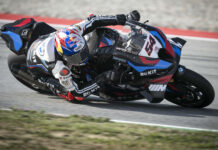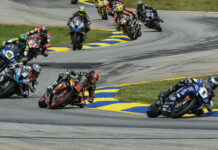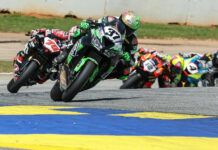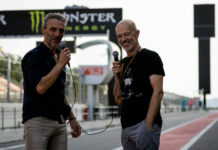Donington Park has hosted the British Grand Prix since 1987 when it took over from the Silverstone circuit which had been the venue for the previous ten years. Before then the British round of the World Championship was staged at the famous 60.721 kms TT circuit on the Isle of Man which was deemed too dangerous in 1977 and hence the switch to the mainland and Silverstone. To accommodate the grand prix, Donington Park was extended in length to its present day configuration of 4.023 kms which resulted in two completely different sections. The first part through the magnificent Craner curves and McLean’s and Coppice corners is loved by the riders while the new stop and start section, including the Melbourne hairpin and Goddards is not so popular but provides some fantastic finishes. Max Biaggi brought the Camel Honda team success at the circuit two years ago after Valentino Rossi crossed the line first but received a time penalty for overtaking under a yellow flag which relegated him to third place. Alex Barros has a good record at the circuit which is situated right next to East Midlands airport. The Brazilian, who rides the Camel Honda this year, has finished third on the podium in 1997, 2001 and 2002. His team-mate Australian Troy Bayliss has good memories of Donington in his British and World Superbike Championship days. He will get big support from the British crowd following his success in the British Superbike Championship. Perhaps Team Principle Sito Pons has the happiest memories of the track. He completed his 100th grand prix in 1989, won the 250cc to clinch his second world title. Unfortunately the facilities at Donington have not kept abreast with the track improvements. Cramped garages and the threat of the paddock flooding in heavy rain have caused the teams major problems in the past. A new pit complex will be built in time for the race next year. Traffic is another problem especially for the teams hoping to get away quickly for the German Grand Prix at the Sachsenring the following weekend. FROM THE SADDLE Alex Barros 4: “I really like the Donington track, it’s got its very own character, fast at the beginning, then stop-and-go at the end, with some of the most crucial braking points in the championship. I’ve already had some good results there and I want another there now, especially now. At Laguna Seca I was very frustrated, angry even, but I cleared things up with Melandri, and now I want to get over it with a good result in England. After the crash in America I took another blow to the back which limited my movements for a few days, but I should be ok by Friday.” Troy Bayliss 12: “At Laguna Seca we did some brilliant work in practice, but in the race I couldn’t get the same feeling in the race. We did however show that we can be quick, now we need the consistency. I would love to have a good race in Britain, my first country after I moved from Australia to take part in the British Superbike series.” —————————————————————– CIRCUIT – UK GRAND PRIX – 24/07/05 DONINGTON PARK —————————————————————– Track data: Length: 4.023 kms Pole Position: Left. Width: 10m Right corners: Seven. Left corners: Four. Longest straight: 0.350 miles Constructed: 1931 Modified: 1985. Lap record: Colin Edwards (Honda) 1:29.973 – 160.968 kph Pole record: Valentino Rossi (Yamaha) 1:28.720 – 163.242 kph. Race winner 2004: Valentino Rossi (Yamaha) 45:30.473 – 159.124 kph 2004 results Troy Bayliss and Alex Barros. Bayliss fifth. Barros ninth. —————————————————————– TECHNICAL INSIGHT – UK GRAND PRIX – 24/07/05 DONINGTON PARK —————————————————————– In the present-day Donington track layout there are two distinct sections: the first is a fast, snaking section where the bike must be stable in the front to negotiate the fast downhill corners “Hollywood” and “Craner curves”, which are taken at more than 200 kph. This first section is all downhill and taken in fifth gear until the legendary “Old Hairpin” corner, where the braking is very delicate since it is the lowest point in the circuit and taken in third gear. After this corner the rider moves through the “Schwantz curve” in fifth gear and on to the “McLean’s Corner”. This is followed by the “Coppice Corner”, taken in third gear and where we often see riders sliding out of the exit of the corner, and then on to the longest straight on the circuit. On this straight, speeds do not normally exceed 275 kph because the straight is on the crest of a hill and when the bikes pass over it they literally take off causing a sudden boost in engine revs which momentarily stops the engine ignition. At this point in the straight each rider has his own particular way of reducing the time lost: some riders change from fifth to sixth at the take off point; others change their line slightly on the crest so that the bike is leaning slightly and this stops the front wheel leaving the ground, although the accelerator must be closed a little and speed must be reduced at the end of the straight. Directly after this straight comes the slowest section of the track with three corners taken at less than 70 Kph followed by three straight taken in fourth and fifth gear. One of these corners is the famous “The Esses”, a very slow chicane, and also the “Melbourne Hairpin”, a hairpin taken at 60 Kph and the slowest point of the track. With this amount of sharp braking the set up of the engine brake with the four-stroke bikes is crucial in allowing for late braking when overtaking. Ideally, at Donington, the riders would need two different chassis geometry’s for the different sections of the track. One would provide stability with a low centre of gravity to allow for rapid changes of direction. Another where the bike would be shorter with a higher centre of so that the bike can turn quickly through the slower, tighter corners. As usual, we must look for an adequate compromise which helps the bike through certain sections and does not lose too much time through the others. Donington is also a circuit with little grip which makes the set up work be even more complicated. There is a saying that this lack of grip is due to the fuel deposited by the aeroplanes that take off and land at the nearby East Midlands airport. Some teams claim that on rainy days you can see the fuel forming a fine film on the track surface making it very slippery. It is difficult to find an ideal setting for the gear ratios since all the gears are used. Since the gear ratios are very short and the lower gears must be used a lot, we find a problem with an excess of power delivery where the bikes do “wheelies”. Just like the Le Mans Bugatti Circuit, at Donington the rider changes gear many times in one lap, on average 33 times per lap, or nearly 1000 during the race. Donington is one of the circuits where there is a high degree of front tyre wear. The first section of the track which is downhill, with seven hard braking points, creates a lot of wear on the front during the race. Normally hard compounds are used in the rear, especially on the right side, mainly to counter the increased wear due to the fast acceleration and sliding when exiting the “Coppice Corner”.
Barros Says He Has Cleared Things Up With Melandri After Laguna Seca Collision
Barros Says He Has Cleared Things Up With Melandri After Laguna Seca Collision
© 2005, Roadracing World Publishing, Inc.






